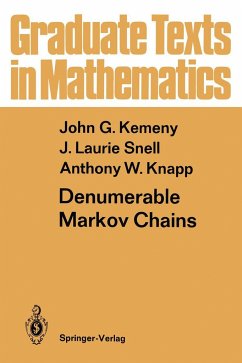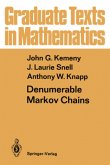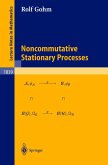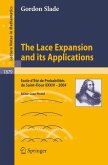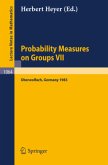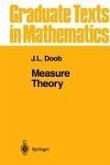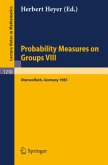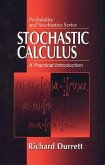John G. Kemeny, J. Laurie Snell, Anthony W. Knapp
Denumerable Markov Chains
with a chapter of Markov Random Fields by David Griffeath
John G. Kemeny, J. Laurie Snell, Anthony W. Knapp
Denumerable Markov Chains
with a chapter of Markov Random Fields by David Griffeath
- Gebundenes Buch
- Merkliste
- Auf die Merkliste
- Bewerten Bewerten
- Teilen
- Produkt teilen
- Produkterinnerung
- Produkterinnerung
This textbook provides a systematic treatment of denumerable Markov chains, covering both the foundations of the subject and some in topics in potential theory and boundary theory. The book is a careful exposition with special emphasis on the clarity of style and presentation.
Andere Kunden interessierten sich auch für
![Denumerable Markov Chains Denumerable Markov Chains]() John G. KemenyDenumerable Markov Chains50,99 €
John G. KemenyDenumerable Markov Chains50,99 €![Noncommutative Stationary Processes Noncommutative Stationary Processes]() R. GohmNoncommutative Stationary Processes27,99 €
R. GohmNoncommutative Stationary Processes27,99 €![The Lace Expansion and its Applications The Lace Expansion and its Applications]() Gordon SladeThe Lace Expansion and its Applications50,99 €
Gordon SladeThe Lace Expansion and its Applications50,99 €![Probability Measure on Groups VII Probability Measure on Groups VII]() Probability Measure on Groups VII35,99 €
Probability Measure on Groups VII35,99 €![Measure Theory Measure Theory]() J. L. DoobMeasure Theory53,99 €
J. L. DoobMeasure Theory53,99 €![Probability Measures on Groups VIII Probability Measures on Groups VIII]() Probability Measures on Groups VIII27,99 €
Probability Measures on Groups VIII27,99 €![Stochastic Calculus Stochastic Calculus]() Richard DurrettStochastic Calculus187,99 €
Richard DurrettStochastic Calculus187,99 €-
-
-
This textbook provides a systematic treatment of denumerable Markov chains, covering both the foundations of the subject and some in topics in potential theory and boundary theory. The book is a careful exposition with special emphasis on the clarity of style and presentation.
Produktdetails
- Produktdetails
- Verlag: Copernicus / Springer / Springer US, New York, N.Y.
- Second Edition 1976
- Seitenzahl: 500
- Erscheinungstermin: 1. September 1976
- Englisch
- Abmessung: 240mm x 161mm x 33mm
- Gewicht: 910g
- ISBN-13: 9780387901770
- ISBN-10: 0387901779
- Artikelnr.: 22223053
- Herstellerkennzeichnung
- Springer-Verlag GmbH
- Tiergartenstr. 17
- 69121 Heidelberg
- ProductSafety@springernature.com
- Verlag: Copernicus / Springer / Springer US, New York, N.Y.
- Second Edition 1976
- Seitenzahl: 500
- Erscheinungstermin: 1. September 1976
- Englisch
- Abmessung: 240mm x 161mm x 33mm
- Gewicht: 910g
- ISBN-13: 9780387901770
- ISBN-10: 0387901779
- Artikelnr.: 22223053
- Herstellerkennzeichnung
- Springer-Verlag GmbH
- Tiergartenstr. 17
- 69121 Heidelberg
- ProductSafety@springernature.com
1: Prerequisites from Analysis.
1. Denumerable Matrices.
2. Measure Theory.
3. Measurable Functions and Lebesgue Integration.
4. Integration Theorems.
5. Limit Theorems for Matrices.
6. Some General Theorems from Analysis.
2: Stochastic Processes.
1. Sequence Spaces.
2. Denumerable Stochastic Processes.
3. Borel Fields in Stochastic Processes.
4. Statements of Probability Zero or One.
5. Conditional Probabilities.
6. Random Variables and Means.
7. Means Conditional on Statements.
8. Problems.
3: Martingales.
1. Means Conditional on Partitions and Functions.
2. Properties of Martingales.
3. A First Martingale Systems Theorem.
4. Martingale Convergence and a Second Systems Theorem.
5. Examples of Convergent Martingales.
6. Law of Large Numbers.
7. Problems.
4: Properties of Markov Chains.
1. Markov Chains.
2. Examples of Markov Chains.
3. Applications of Martingale Ideas.
4. Strong Markov Property.
5. Systems Theorems for Markov Chains.
6. Applications of Systems Theorems.
7. Classification of States.
8. Problems.
5: Transient Chains.
1. Properties of Transient Chains.
2. Superregular Functions.
3. Absorbing Chains.
4. Finite Drunkard's Walk.
5. Infinite Drunkard's Walk.
6. A Zero
One Law for Sums of Independent Random Variables.
7. Sums of Independent Random Variables on the Line.
8. Examples of Sums of Independent Random Variables.
9. Ladder Process for Sums of Independent Random Variables.
10. The Basic Example.
11. Problems.
6: Recurrent Chains.
1. Mean Ergodic Theorem for Markov Chains.
2. Duality.
3. Cyclicity.
4. Sums of Independent Random Variables.
5. Convergence Theorem for Noncyclic Chains.
6. Mean First Passage Time Matrix.
7. Examples of the Mean First Passage Time Matrix.
8. Reverse Markov Chains.
9.Problems.
7: Introduction to Potential Theory.
1. Brownian Motion.
2. Potential Theory.
3. Equivalence of Brownian Motion and Potential Theory.
4. Brownian Motion and Potential Theory in n Dimensions.
5. Potential Theory for Denumerable Markov Chains.
6. Brownian Motion as a Limit of the Symmetric Random Walk.
7. Symmetric Random Walk in n Dimensions.
8: Transient Potential Theory.
1. Potentials.
2. The h
Process and Some Applications.
3. Equilibrium Sets and Capacities.
4. Potential Principles.
5. Energy.
6. The Basic Example.
7. An Unbounded Potential.
8. Applications of Potential
Theoretic Methods.
9. General Denumerable Stochastic Processes.
10. Problems.
9: Recurrent Potential Theory.
1. Potentials.
2. Normal Chains.
3. Ergodic Chains.
4. Classes of Ergodic Chains.
5. Strong Ergodic Chains.
6. The Basic Example.
7. Further Examples.
8. The Operator K.
9. Potential Principles.
10. A Model for Potential Theory.
11. A Nonnormal Chain and Other Examples.
12. Two
Dimensional Symmetric Random Walk.
13. Problems.
10: Transient Boundary Theory.
1. Motivation for Martin Boundary Theory.
2. Extended Chains.
3. Martin Exit Boundary.
4. Convergence to the Boundary.
5. Poisson
Martin Representation Theorem.
6. Extreme Points of the Boundary.
7. Uniqueness of the Representation.
8. Analog of Fatou's Theorem.
9. Fine Boundary Functions.
10. Martin Entrance Boundary.
11. Application to Extended Chains.
12. Proof of Theorem 10.9.
13. Examples.
14. Problems.
11: Recurrent Boundary Theory.
1. Entrance Boundary for Recurrent Chains.
2. Measures on the Entrance Boundary.
3. Harmonic Measure for Normal Chains.
4. Continuous and T
Continuous Functions.
5. Normal Chains and Convergence to the Boundary.
6. Representation Theorem.
7. Sums of Independent Random Variables.
8. Examples.
9. Problems.
12: Introduction to Random Fields.
1 Markov Fields.
2. Finite Gibbs Fields.
3. Equivalence of Finite Markov and Neighbor Gibbs Fields.
4. Markov Fields and Neighbor Gibbs Fields: the Infinite Case.
5. Homogeneous Markov Fields on the Integers.
6. Examples of Phase Multiplicity in Higher Dimensions.
7. Problems.
Notes.
Additional Notes.
References.
Additional References.
Index of Notation.
1. Denumerable Matrices.
2. Measure Theory.
3. Measurable Functions and Lebesgue Integration.
4. Integration Theorems.
5. Limit Theorems for Matrices.
6. Some General Theorems from Analysis.
2: Stochastic Processes.
1. Sequence Spaces.
2. Denumerable Stochastic Processes.
3. Borel Fields in Stochastic Processes.
4. Statements of Probability Zero or One.
5. Conditional Probabilities.
6. Random Variables and Means.
7. Means Conditional on Statements.
8. Problems.
3: Martingales.
1. Means Conditional on Partitions and Functions.
2. Properties of Martingales.
3. A First Martingale Systems Theorem.
4. Martingale Convergence and a Second Systems Theorem.
5. Examples of Convergent Martingales.
6. Law of Large Numbers.
7. Problems.
4: Properties of Markov Chains.
1. Markov Chains.
2. Examples of Markov Chains.
3. Applications of Martingale Ideas.
4. Strong Markov Property.
5. Systems Theorems for Markov Chains.
6. Applications of Systems Theorems.
7. Classification of States.
8. Problems.
5: Transient Chains.
1. Properties of Transient Chains.
2. Superregular Functions.
3. Absorbing Chains.
4. Finite Drunkard's Walk.
5. Infinite Drunkard's Walk.
6. A Zero
One Law for Sums of Independent Random Variables.
7. Sums of Independent Random Variables on the Line.
8. Examples of Sums of Independent Random Variables.
9. Ladder Process for Sums of Independent Random Variables.
10. The Basic Example.
11. Problems.
6: Recurrent Chains.
1. Mean Ergodic Theorem for Markov Chains.
2. Duality.
3. Cyclicity.
4. Sums of Independent Random Variables.
5. Convergence Theorem for Noncyclic Chains.
6. Mean First Passage Time Matrix.
7. Examples of the Mean First Passage Time Matrix.
8. Reverse Markov Chains.
9.Problems.
7: Introduction to Potential Theory.
1. Brownian Motion.
2. Potential Theory.
3. Equivalence of Brownian Motion and Potential Theory.
4. Brownian Motion and Potential Theory in n Dimensions.
5. Potential Theory for Denumerable Markov Chains.
6. Brownian Motion as a Limit of the Symmetric Random Walk.
7. Symmetric Random Walk in n Dimensions.
8: Transient Potential Theory.
1. Potentials.
2. The h
Process and Some Applications.
3. Equilibrium Sets and Capacities.
4. Potential Principles.
5. Energy.
6. The Basic Example.
7. An Unbounded Potential.
8. Applications of Potential
Theoretic Methods.
9. General Denumerable Stochastic Processes.
10. Problems.
9: Recurrent Potential Theory.
1. Potentials.
2. Normal Chains.
3. Ergodic Chains.
4. Classes of Ergodic Chains.
5. Strong Ergodic Chains.
6. The Basic Example.
7. Further Examples.
8. The Operator K.
9. Potential Principles.
10. A Model for Potential Theory.
11. A Nonnormal Chain and Other Examples.
12. Two
Dimensional Symmetric Random Walk.
13. Problems.
10: Transient Boundary Theory.
1. Motivation for Martin Boundary Theory.
2. Extended Chains.
3. Martin Exit Boundary.
4. Convergence to the Boundary.
5. Poisson
Martin Representation Theorem.
6. Extreme Points of the Boundary.
7. Uniqueness of the Representation.
8. Analog of Fatou's Theorem.
9. Fine Boundary Functions.
10. Martin Entrance Boundary.
11. Application to Extended Chains.
12. Proof of Theorem 10.9.
13. Examples.
14. Problems.
11: Recurrent Boundary Theory.
1. Entrance Boundary for Recurrent Chains.
2. Measures on the Entrance Boundary.
3. Harmonic Measure for Normal Chains.
4. Continuous and T
Continuous Functions.
5. Normal Chains and Convergence to the Boundary.
6. Representation Theorem.
7. Sums of Independent Random Variables.
8. Examples.
9. Problems.
12: Introduction to Random Fields.
1 Markov Fields.
2. Finite Gibbs Fields.
3. Equivalence of Finite Markov and Neighbor Gibbs Fields.
4. Markov Fields and Neighbor Gibbs Fields: the Infinite Case.
5. Homogeneous Markov Fields on the Integers.
6. Examples of Phase Multiplicity in Higher Dimensions.
7. Problems.
Notes.
Additional Notes.
References.
Additional References.
Index of Notation.
1: Prerequisites from Analysis.- 1. Denumerable Matrices.- 2. Measure Theory.- 3. Measurable Functions and Lebesgue Integration.- 4. Integration Theorems.- 5. Limit Theorems for Matrices.- 6. Some General Theorems from Analysis.- 2: Stochastic Processes.- 1. Sequence Spaces.- 2. Denumerable Stochastic Processes.- 3. Borel Fields in Stochastic Processes.- 4. Statements of Probability Zero or One.- 5. Conditional Probabilities.- 6. Random Variables and Means.- 7. Means Conditional on Statements.- 8. Problems.- 3: Martingales.- 1. Means Conditional on Partitions and Functions.- 2. Properties of Martingales.- 3. A First Martingale Systems Theorem.- 4. Martingale Convergence and a Second Systems Theorem.- 5. Examples of Convergent Martingales.- 6. Law of Large Numbers.- 7. Problems.- 4: Properties of Markov Chains.- 1. Markov Chains.- 2. Examples of Markov Chains.- 3. Applications of Martingale Ideas.- 4. Strong Markov Property.- 5. Systems Theorems for Markov Chains.- 6. Applications of Systems Theorems.- 7. Classification of States.- 8. Problems.- 5: Transient Chains.- 1. Properties of Transient Chains.- 2. Superregular Functions.- 3. Absorbing Chains.- 4. Finite Drunkard's Walk.- 5. Infinite Drunkard's Walk.- 6. A Zero-One Law for Sums of Independent Random Variables.- 7. Sums of Independent Random Variables on the Line.- 8. Examples of Sums of Independent Random Variables.- 9. Ladder Process for Sums of Independent Random Variables.- 10. The Basic Example.- 11. Problems.- 6: Recurrent Chains.- 1. Mean Ergodic Theorem for Markov Chains.- 2. Duality.- 3. Cyclicity.- 4. Sums of Independent Random Variables.- 5. Convergence Theorem for Noncyclic Chains.- 6. Mean First Passage Time Matrix.- 7. Examples of the Mean First Passage Time Matrix.- 8. Reverse Markov Chains.- 9.Problems.- 7: Introduction to Potential Theory.- 1. Brownian Motion.- 2. Potential Theory.- 3. Equivalence of Brownian Motion and Potential Theory.- 4. Brownian Motion and Potential Theory in n Dimensions.- 5. Potential Theory for Denumerable Markov Chains.- 6. Brownian Motion as a Limit of the Symmetric Random Walk.- 7. Symmetric Random Walk in n Dimensions.- 8: Transient Potential Theory.- 1. Potentials.- 2. The h-Process and Some Applications.- 3. Equilibrium Sets and Capacities.- 4. Potential Principles.- 5. Energy.- 6. The Basic Example.- 7. An Unbounded Potential.- 8. Applications of Potential-Theoretic Methods.- 9. General Denumerable Stochastic Processes.- 10. Problems.- 9: Recurrent Potential Theory.- 1. Potentials.- 2. Normal Chains.- 3. Ergodic Chains.- 4. Classes of Ergodic Chains.- 5. Strong Ergodic Chains.- 6. The Basic Example.- 7. Further Examples.- 8. The Operator K.- 9. Potential Principles.- 10. A Model for Potential Theory.- 11. A Nonnormal Chain and Other Examples.- 12. Two-Dimensional Symmetric Random Walk.- 13. Problems.- 10: Transient Boundary Theory.- 1. Motivation for Martin Boundary Theory.- 2. Extended Chains.- 3. Martin Exit Boundary.- 4. Convergence to the Boundary.- 5. Poisson-Martin Representation Theorem.- 6. Extreme Points of the Boundary.- 7. Uniqueness of the Representation.- 8. Analog of Fatou's Theorem.- 9. Fine Boundary Functions.- 10. Martin Entrance Boundary.- 11. Application to Extended Chains.- 12. Proof of Theorem 10.9.- 13. Examples.- 14. Problems.- 11: Recurrent Boundary Theory.- 1. Entrance Boundary for Recurrent Chains.- 2. Measures on the Entrance Boundary.- 3. Harmonic Measure for Normal Chains.- 4. Continuous and T-Continuous Functions.- 5. Normal Chains and Convergence to the Boundary.- 6. Representation Theorem.-7. Sums of Independent Random Variables.- 8. Examples.- 9. Problems.- 12: Introduction to Random Fields.- 1 Markov Fields.- 2. Finite Gibbs Fields.- 3. Equivalence of Finite Markov and Neighbor Gibbs Fields.- 4. Markov Fields and Neighbor Gibbs Fields: the Infinite Case.- 5. Homogeneous Markov Fields on the Integers.- 6. Examples of Phase Multiplicity in Higher Dimensions.- 7. Problems.- Notes.- Additional Notes.- References.- Additional References.- Index of Notation.
1: Prerequisites from Analysis.
1. Denumerable Matrices.
2. Measure Theory.
3. Measurable Functions and Lebesgue Integration.
4. Integration Theorems.
5. Limit Theorems for Matrices.
6. Some General Theorems from Analysis.
2: Stochastic Processes.
1. Sequence Spaces.
2. Denumerable Stochastic Processes.
3. Borel Fields in Stochastic Processes.
4. Statements of Probability Zero or One.
5. Conditional Probabilities.
6. Random Variables and Means.
7. Means Conditional on Statements.
8. Problems.
3: Martingales.
1. Means Conditional on Partitions and Functions.
2. Properties of Martingales.
3. A First Martingale Systems Theorem.
4. Martingale Convergence and a Second Systems Theorem.
5. Examples of Convergent Martingales.
6. Law of Large Numbers.
7. Problems.
4: Properties of Markov Chains.
1. Markov Chains.
2. Examples of Markov Chains.
3. Applications of Martingale Ideas.
4. Strong Markov Property.
5. Systems Theorems for Markov Chains.
6. Applications of Systems Theorems.
7. Classification of States.
8. Problems.
5: Transient Chains.
1. Properties of Transient Chains.
2. Superregular Functions.
3. Absorbing Chains.
4. Finite Drunkard's Walk.
5. Infinite Drunkard's Walk.
6. A Zero
One Law for Sums of Independent Random Variables.
7. Sums of Independent Random Variables on the Line.
8. Examples of Sums of Independent Random Variables.
9. Ladder Process for Sums of Independent Random Variables.
10. The Basic Example.
11. Problems.
6: Recurrent Chains.
1. Mean Ergodic Theorem for Markov Chains.
2. Duality.
3. Cyclicity.
4. Sums of Independent Random Variables.
5. Convergence Theorem for Noncyclic Chains.
6. Mean First Passage Time Matrix.
7. Examples of the Mean First Passage Time Matrix.
8. Reverse Markov Chains.
9.Problems.
7: Introduction to Potential Theory.
1. Brownian Motion.
2. Potential Theory.
3. Equivalence of Brownian Motion and Potential Theory.
4. Brownian Motion and Potential Theory in n Dimensions.
5. Potential Theory for Denumerable Markov Chains.
6. Brownian Motion as a Limit of the Symmetric Random Walk.
7. Symmetric Random Walk in n Dimensions.
8: Transient Potential Theory.
1. Potentials.
2. The h
Process and Some Applications.
3. Equilibrium Sets and Capacities.
4. Potential Principles.
5. Energy.
6. The Basic Example.
7. An Unbounded Potential.
8. Applications of Potential
Theoretic Methods.
9. General Denumerable Stochastic Processes.
10. Problems.
9: Recurrent Potential Theory.
1. Potentials.
2. Normal Chains.
3. Ergodic Chains.
4. Classes of Ergodic Chains.
5. Strong Ergodic Chains.
6. The Basic Example.
7. Further Examples.
8. The Operator K.
9. Potential Principles.
10. A Model for Potential Theory.
11. A Nonnormal Chain and Other Examples.
12. Two
Dimensional Symmetric Random Walk.
13. Problems.
10: Transient Boundary Theory.
1. Motivation for Martin Boundary Theory.
2. Extended Chains.
3. Martin Exit Boundary.
4. Convergence to the Boundary.
5. Poisson
Martin Representation Theorem.
6. Extreme Points of the Boundary.
7. Uniqueness of the Representation.
8. Analog of Fatou's Theorem.
9. Fine Boundary Functions.
10. Martin Entrance Boundary.
11. Application to Extended Chains.
12. Proof of Theorem 10.9.
13. Examples.
14. Problems.
11: Recurrent Boundary Theory.
1. Entrance Boundary for Recurrent Chains.
2. Measures on the Entrance Boundary.
3. Harmonic Measure for Normal Chains.
4. Continuous and T
Continuous Functions.
5. Normal Chains and Convergence to the Boundary.
6. Representation Theorem.
7. Sums of Independent Random Variables.
8. Examples.
9. Problems.
12: Introduction to Random Fields.
1 Markov Fields.
2. Finite Gibbs Fields.
3. Equivalence of Finite Markov and Neighbor Gibbs Fields.
4. Markov Fields and Neighbor Gibbs Fields: the Infinite Case.
5. Homogeneous Markov Fields on the Integers.
6. Examples of Phase Multiplicity in Higher Dimensions.
7. Problems.
Notes.
Additional Notes.
References.
Additional References.
Index of Notation.
1. Denumerable Matrices.
2. Measure Theory.
3. Measurable Functions and Lebesgue Integration.
4. Integration Theorems.
5. Limit Theorems for Matrices.
6. Some General Theorems from Analysis.
2: Stochastic Processes.
1. Sequence Spaces.
2. Denumerable Stochastic Processes.
3. Borel Fields in Stochastic Processes.
4. Statements of Probability Zero or One.
5. Conditional Probabilities.
6. Random Variables and Means.
7. Means Conditional on Statements.
8. Problems.
3: Martingales.
1. Means Conditional on Partitions and Functions.
2. Properties of Martingales.
3. A First Martingale Systems Theorem.
4. Martingale Convergence and a Second Systems Theorem.
5. Examples of Convergent Martingales.
6. Law of Large Numbers.
7. Problems.
4: Properties of Markov Chains.
1. Markov Chains.
2. Examples of Markov Chains.
3. Applications of Martingale Ideas.
4. Strong Markov Property.
5. Systems Theorems for Markov Chains.
6. Applications of Systems Theorems.
7. Classification of States.
8. Problems.
5: Transient Chains.
1. Properties of Transient Chains.
2. Superregular Functions.
3. Absorbing Chains.
4. Finite Drunkard's Walk.
5. Infinite Drunkard's Walk.
6. A Zero
One Law for Sums of Independent Random Variables.
7. Sums of Independent Random Variables on the Line.
8. Examples of Sums of Independent Random Variables.
9. Ladder Process for Sums of Independent Random Variables.
10. The Basic Example.
11. Problems.
6: Recurrent Chains.
1. Mean Ergodic Theorem for Markov Chains.
2. Duality.
3. Cyclicity.
4. Sums of Independent Random Variables.
5. Convergence Theorem for Noncyclic Chains.
6. Mean First Passage Time Matrix.
7. Examples of the Mean First Passage Time Matrix.
8. Reverse Markov Chains.
9.Problems.
7: Introduction to Potential Theory.
1. Brownian Motion.
2. Potential Theory.
3. Equivalence of Brownian Motion and Potential Theory.
4. Brownian Motion and Potential Theory in n Dimensions.
5. Potential Theory for Denumerable Markov Chains.
6. Brownian Motion as a Limit of the Symmetric Random Walk.
7. Symmetric Random Walk in n Dimensions.
8: Transient Potential Theory.
1. Potentials.
2. The h
Process and Some Applications.
3. Equilibrium Sets and Capacities.
4. Potential Principles.
5. Energy.
6. The Basic Example.
7. An Unbounded Potential.
8. Applications of Potential
Theoretic Methods.
9. General Denumerable Stochastic Processes.
10. Problems.
9: Recurrent Potential Theory.
1. Potentials.
2. Normal Chains.
3. Ergodic Chains.
4. Classes of Ergodic Chains.
5. Strong Ergodic Chains.
6. The Basic Example.
7. Further Examples.
8. The Operator K.
9. Potential Principles.
10. A Model for Potential Theory.
11. A Nonnormal Chain and Other Examples.
12. Two
Dimensional Symmetric Random Walk.
13. Problems.
10: Transient Boundary Theory.
1. Motivation for Martin Boundary Theory.
2. Extended Chains.
3. Martin Exit Boundary.
4. Convergence to the Boundary.
5. Poisson
Martin Representation Theorem.
6. Extreme Points of the Boundary.
7. Uniqueness of the Representation.
8. Analog of Fatou's Theorem.
9. Fine Boundary Functions.
10. Martin Entrance Boundary.
11. Application to Extended Chains.
12. Proof of Theorem 10.9.
13. Examples.
14. Problems.
11: Recurrent Boundary Theory.
1. Entrance Boundary for Recurrent Chains.
2. Measures on the Entrance Boundary.
3. Harmonic Measure for Normal Chains.
4. Continuous and T
Continuous Functions.
5. Normal Chains and Convergence to the Boundary.
6. Representation Theorem.
7. Sums of Independent Random Variables.
8. Examples.
9. Problems.
12: Introduction to Random Fields.
1 Markov Fields.
2. Finite Gibbs Fields.
3. Equivalence of Finite Markov and Neighbor Gibbs Fields.
4. Markov Fields and Neighbor Gibbs Fields: the Infinite Case.
5. Homogeneous Markov Fields on the Integers.
6. Examples of Phase Multiplicity in Higher Dimensions.
7. Problems.
Notes.
Additional Notes.
References.
Additional References.
Index of Notation.
1: Prerequisites from Analysis.- 1. Denumerable Matrices.- 2. Measure Theory.- 3. Measurable Functions and Lebesgue Integration.- 4. Integration Theorems.- 5. Limit Theorems for Matrices.- 6. Some General Theorems from Analysis.- 2: Stochastic Processes.- 1. Sequence Spaces.- 2. Denumerable Stochastic Processes.- 3. Borel Fields in Stochastic Processes.- 4. Statements of Probability Zero or One.- 5. Conditional Probabilities.- 6. Random Variables and Means.- 7. Means Conditional on Statements.- 8. Problems.- 3: Martingales.- 1. Means Conditional on Partitions and Functions.- 2. Properties of Martingales.- 3. A First Martingale Systems Theorem.- 4. Martingale Convergence and a Second Systems Theorem.- 5. Examples of Convergent Martingales.- 6. Law of Large Numbers.- 7. Problems.- 4: Properties of Markov Chains.- 1. Markov Chains.- 2. Examples of Markov Chains.- 3. Applications of Martingale Ideas.- 4. Strong Markov Property.- 5. Systems Theorems for Markov Chains.- 6. Applications of Systems Theorems.- 7. Classification of States.- 8. Problems.- 5: Transient Chains.- 1. Properties of Transient Chains.- 2. Superregular Functions.- 3. Absorbing Chains.- 4. Finite Drunkard's Walk.- 5. Infinite Drunkard's Walk.- 6. A Zero-One Law for Sums of Independent Random Variables.- 7. Sums of Independent Random Variables on the Line.- 8. Examples of Sums of Independent Random Variables.- 9. Ladder Process for Sums of Independent Random Variables.- 10. The Basic Example.- 11. Problems.- 6: Recurrent Chains.- 1. Mean Ergodic Theorem for Markov Chains.- 2. Duality.- 3. Cyclicity.- 4. Sums of Independent Random Variables.- 5. Convergence Theorem for Noncyclic Chains.- 6. Mean First Passage Time Matrix.- 7. Examples of the Mean First Passage Time Matrix.- 8. Reverse Markov Chains.- 9.Problems.- 7: Introduction to Potential Theory.- 1. Brownian Motion.- 2. Potential Theory.- 3. Equivalence of Brownian Motion and Potential Theory.- 4. Brownian Motion and Potential Theory in n Dimensions.- 5. Potential Theory for Denumerable Markov Chains.- 6. Brownian Motion as a Limit of the Symmetric Random Walk.- 7. Symmetric Random Walk in n Dimensions.- 8: Transient Potential Theory.- 1. Potentials.- 2. The h-Process and Some Applications.- 3. Equilibrium Sets and Capacities.- 4. Potential Principles.- 5. Energy.- 6. The Basic Example.- 7. An Unbounded Potential.- 8. Applications of Potential-Theoretic Methods.- 9. General Denumerable Stochastic Processes.- 10. Problems.- 9: Recurrent Potential Theory.- 1. Potentials.- 2. Normal Chains.- 3. Ergodic Chains.- 4. Classes of Ergodic Chains.- 5. Strong Ergodic Chains.- 6. The Basic Example.- 7. Further Examples.- 8. The Operator K.- 9. Potential Principles.- 10. A Model for Potential Theory.- 11. A Nonnormal Chain and Other Examples.- 12. Two-Dimensional Symmetric Random Walk.- 13. Problems.- 10: Transient Boundary Theory.- 1. Motivation for Martin Boundary Theory.- 2. Extended Chains.- 3. Martin Exit Boundary.- 4. Convergence to the Boundary.- 5. Poisson-Martin Representation Theorem.- 6. Extreme Points of the Boundary.- 7. Uniqueness of the Representation.- 8. Analog of Fatou's Theorem.- 9. Fine Boundary Functions.- 10. Martin Entrance Boundary.- 11. Application to Extended Chains.- 12. Proof of Theorem 10.9.- 13. Examples.- 14. Problems.- 11: Recurrent Boundary Theory.- 1. Entrance Boundary for Recurrent Chains.- 2. Measures on the Entrance Boundary.- 3. Harmonic Measure for Normal Chains.- 4. Continuous and T-Continuous Functions.- 5. Normal Chains and Convergence to the Boundary.- 6. Representation Theorem.-7. Sums of Independent Random Variables.- 8. Examples.- 9. Problems.- 12: Introduction to Random Fields.- 1 Markov Fields.- 2. Finite Gibbs Fields.- 3. Equivalence of Finite Markov and Neighbor Gibbs Fields.- 4. Markov Fields and Neighbor Gibbs Fields: the Infinite Case.- 5. Homogeneous Markov Fields on the Integers.- 6. Examples of Phase Multiplicity in Higher Dimensions.- 7. Problems.- Notes.- Additional Notes.- References.- Additional References.- Index of Notation.

